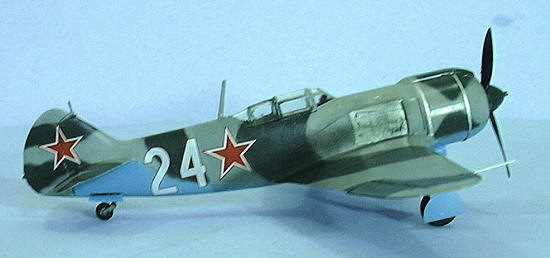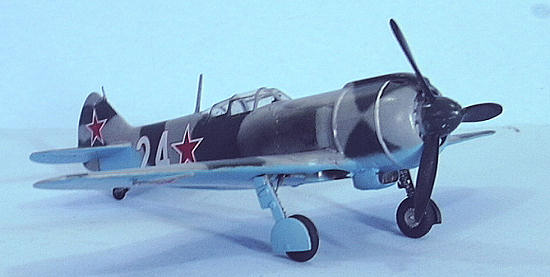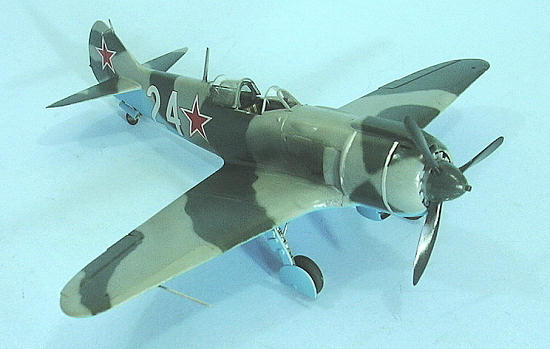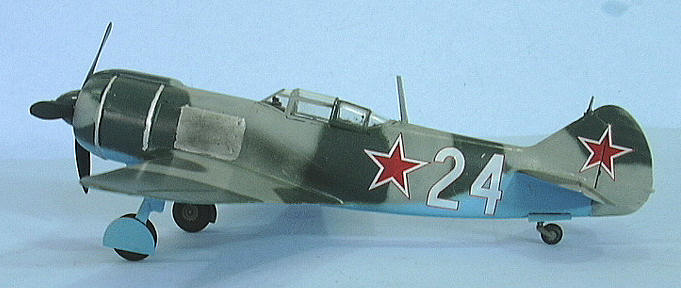The Lavochkin La-5 was developed from the earlier LaGG-1 and LaGG-3
fighters, which had suffered from too-heavy airframes and lack of a
suitably-powerful engine. They
were among the least popular fighters used by the V-VS during the Great
Patriotic War and were known by a play on the aircraft designation which
translated as “varnished guaranteed coffin,” which said everything one
wanted to know about the deficiencies.
By late 1941, Stalin was commenting negatively on the LaGG-3 and the
factories previously committed to the production of the LaGG-3 were turned
over to Yakovlev for the production of the Yak-1 and Yak-7 fighters, which
were notably superior designs. Motivated by fear of being imprisoned for sabotage by the NKVD for the
failure of the LaGG-3, two of the designers - Semyon Lavochkin and Vladimir
Gorbunov - decided to make a radical attempt at giving the fighter
sufficient power, experimentally fitting a LaGG-3 with the Shvetsov ASh-82A
radial engine. The design work
required to adapt the LaGG-3 to the new engine and still maintain the
aircraft's balance was undertaken by Lavochkin in a small hut beside an
airfield over the winter of 1941-1942, all completely unofficially.
Ultimately, Lavochkin accomplished his goal by grafting the nose
section of a Sukhoi Su-2 to the narrow  fuselage
of the LaGG-3.
fuselage
of the LaGG-3.
When the prototype took flight in March, 1942, the results were
gratifying. The fighter finally
had a powerplant powerful enough to perform well in the air.
The LaG-5 - the designation change noting that one of the original
designers was no longer involved - was declared superior to the Yak-7, by
the initial test pilots. Intensive flight tests began in April, and while the design was still
inferior to German fighters at altitudes over 15,000 feet, it was faster
than both the Bf-109 and the Fw-190 at altitudes below 15,000 feet and was
more maneuverable than either German fighter at low altitude; given that
nearly all air combat on the Eastern Front took place at altitudes under
15,000 ft, the new design was
very much in its element. With
the additional power of the new engine, armament was upgraded to two 20mm
Berezin B-20 cannon, making it the most heavily-armed Soviet fighter. With
the test results so good, Stalin ordered maximum-rate production in July,
1942. Known as the La-5 after
the departure of Gorbunov, production also included conversion of incomplete
LaGG-3 airframes to the new design. configuration.
Before the La-5 went into production, a modified prototype had flown
with a cut-down rear fuselage and an all-round vision canopy, similar to
that of the Yak-1b. While the
need was so great, the La-5 went immediately into production using the
unfinished LaGG-3 airframes. In
March 1943, production moved on to the La-5F, which featured the cut-down
fuselage, with an ASh-82F (“Forsirovanny” - boosted) engine, which
had the same output but gave improved performance at a higher altitude than
 the
earlier ASh-82A.
the
earlier ASh-82A.
The definitive La-5FN (“Forsirovanny Neprosredstvenno”
- Directly Boosted) first left the factory on march 23, 1943.
It is considered a parallel development of the La-5F rather than a
successor, and both continued in simultaneous production through most of the
remainder of 1943. The
engine was the ASh-82FN, which produced 1,850 h.p., 150 h.p. more than the
ASh-82F, which was the result of replacing the carburetors with direct fuel
injection. Visually, the La-5FN
was distinguished by a long supercharger air intake atop the cowling.
The La-5FN had a top speed of 369 mph at sea level, which was 24 mph
greater than the La-5F, taking only 4.7 minutes to reach 5,000 meters as
opposed to the 5.5 minutes of the La-5F.
Comparison tests with and La-5FN and a captured Bf-109G-2 revealed
the Lavochkin was faster and more maneuverable at the lower altitudes where
combat took place.
The La-5FN first entered combat with the 32nd Guards
Fighter Regiment during the Battle
of Kursk.
The unit scored 33 victories during the battle, including 21 Fw-190As
and 3 Bf-109Gs. The aircraft remained in production until November 1944,
when it gave way to the La-7.
There have been two other kits done of the La-5FN in 1/48 scale.
The first was a vacuform done by Falcon in the mid-1980s which was
accurate and the only kit to provide the diamond-shaped “FN” marking, as
well as markings for several other airplanes, including one flown by Ivan
Kozhedub, the top-scoring Soviet pilot of the Great Patriotic War.
Hobbycraft released an  La5FN
which was hopelessly inaccurate - the best that could be said for it would
be it would be useful to use detail parts from this to modernize the Falcon
vacuform kit. This kit from Zvezda was released late last year and is the
most accurate kit of the type available.
La5FN
which was hopelessly inaccurate - the best that could be said for it would
be it would be useful to use detail parts from this to modernize the Falcon
vacuform kit. This kit from Zvezda was released late last year and is the
most accurate kit of the type available.
The kit is highly detailed with a very complete interior.
As with many plastic kits that have a complete interior, the best way
to build the model if you want to display all that detail is to open it up.
It’s not Tami-gawa production quality, but it is far from a “limited
run” kit either. While one does
need to clean up flash here and there, the good news is that all the parts
fit right and assembly can be done with a minimum of hassle.
Decals are provided for one aircraft.
These aren’t great but “they’ll do” if you do not have access to
aftermarket decals. The “Fighting Lavochkins” sheet from Aeromaster provides
markings for the best-known La-5FN, that flown by Hero of the Soviet Union Vitali Popkov.
 Assembly of the La-5FN kit differs from that of the La-5 kit only in
the canopy.
Assembly of the La-5FN kit differs from that of the La-5 kit only in
the canopy.
At the outset of assembly, the modeler has to ask themselves what the
ultimate result will be. If all
the parts are going to be used, then one has to do it opened up.
If you decide to do it “buttoned up” then all those nice detail parts
should be put aside.
I did find in assembly that using the fuselage interior pieces in the
rear fuselage did a great job of insuring accurate final assembly.
I did cut off the engine mounts and only used the very front of the
engine in the assembly, since you cannot see much - if any - of it once you
have the spinner and fan in position.
I painted the interior a greenish shade that was a mixture of
Xtracrylix RLM63 Grey-Green and RLM62 Green suggested to my by Bill Bosworth
as being close to the color he had found when he examined the Il-2 that
Accurate Miniatures researched for their kit.
Eduard makes a very nice photo-etch set for the La-5FN kit, and I
used it for the photo-etch instrument panels, seat belts and other cockpit
details.
All the control surfaces - ailerons, slats, elevators and rudder -
are separate. These fit very
nicely but if you are going to pose them in other than the neutral position
you will have to sand them a bit to modify the shape correctly at the hinge
lines.
Painting:
 I used Tamiya paint mixes for the Light Grey and Green-Grey and Light
Blue camouflage colors to match the colors shown on profiles at Erik
Pilawski’s site “Modeling the V-VS.” leads me to believe that La-5s were
done in the 2-color scheme
I used Tamiya paint mixes for the Light Grey and Green-Grey and Light
Blue camouflage colors to match the colors shown on profiles at Erik
Pilawski’s site “Modeling the V-VS.” leads me to believe that La-5s were
done in the 2-color scheme
Decals:
I used a mixture of decals from my collection of sheets for Soviet
aircraft to make an anonymous La-5FN seen at Tri-Duby airfield during the
Slovak National Rising, and probably flown by the 1st
Czechoslovak Fighter Regiment.
The model received a coat of Xtracrylix “Satin” varnish, and then the
canopy was unmasked and the landing gear and prop attached.
Tamiya “Smoke” was used for the exhaust staining.
I really like the Lavochkin La-5 series; they are in fact my favorite
Soviet fighters of the Great Patriotic War.
This kit is easy to assemble and presents no problems the average
modeler cannot deal with. The
result is a really nice-looking addition to any collection of famous
aircraft of the Second World War.
Thanks to HobbyLink Japan
for the review kit. Get yours
at www.hlj.com
Tom Cleaver
September 2009


 fuselage
of the LaGG-3.
fuselage
of the LaGG-3.  the
earlier ASh-82A.
the
earlier ASh-82A. La5FN
which was hopelessly inaccurate - the best that could be said for it would
be it would be useful to use detail parts from this to modernize the Falcon
vacuform kit. This kit from Zvezda was released late last year and is the
most accurate kit of the type available.
La5FN
which was hopelessly inaccurate - the best that could be said for it would
be it would be useful to use detail parts from this to modernize the Falcon
vacuform kit. This kit from Zvezda was released late last year and is the
most accurate kit of the type available. Assembly of the La-5FN kit differs from that of the La-5 kit only in
the canopy.
Assembly of the La-5FN kit differs from that of the La-5 kit only in
the canopy.